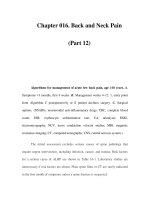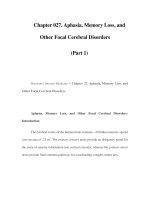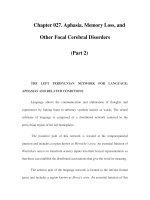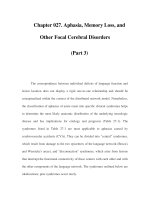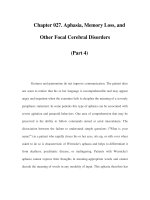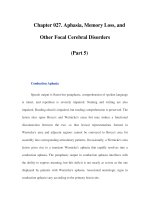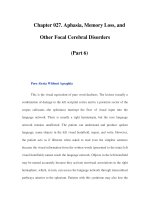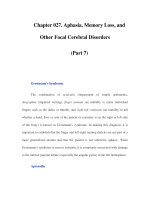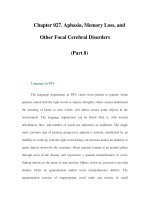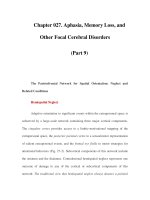Chapter 031. Pharyngitis, Sinusitis, Otitis, and Other Upper Respiratory Tract Infections (Part 12) pdf
Bạn đang xem bản rút gọn của tài liệu. Xem và tải ngay bản đầy đủ của tài liệu tại đây (13.76 KB, 5 trang )
Chapter 031. Pharyngitis, Sinusitis, Otitis, and Other
Upper Respiratory Tract Infections
(Part 12)
Infections of the Larynx and Epiglottis
Laryngitis
Laryngitis is defined as any inflammatory process involving the larynx and
can be caused by a variety of infectious and noninfectious processes. The vast
majority of laryngitis cases seen in clinical practice in developed countries are
acute. Acute laryngitis is a common syndrome caused predominantly by the same
viruses responsible for many other URIs. In fact, most cases of acute laryngitis
occur in the setting of a viral URI.
Etiology
Nearly all major respiratory viruses have been implicated in acute viral
laryngitis, including rhinovirus, influenza virus, parainfluenza virus, adenovirus,
coxsackievirus, coronavirus, and RSV. Acute laryngitis can also be associated
with acute bacterial respiratory infections, such as those caused by group A
Streptococcus or C. diphtheriae (although diphtheria has been all but eliminated in
the United States). Another bacterial pathogen thought to play a role (albeit
unclear) in the pathogenesis of acute laryngitis is M. catarrhalis, which has been
recovered on nasopharyngeal culture from a significant percentage of people with
acute laryngitis. Chronic laryngitis of infectious etiology is much less common in
developed than in developing countries. Laryngitis due to Mycobacterium
tuberculosis is often difficult to distinguish from laryngeal cancer, in part because
of the frequent absence of signs, symptoms, and radiographic findings typical of
pulmonary disease. Histoplasma and Blastomyces may cause laryngitis, often as a
complication of systemic infection. Candida species can cause laryngitis as well,
often in association with thrush or esophagitis and particularly in
immunosuppressed patients. Rare cases of chronic laryngitis are due to
Coccidioides and Cryptococcus.
Clinical Manifestations
Laryngitis is characterized by hoarseness and can also be associated with
reduced vocal pitch or aphonia. As acute laryngitis is caused predominantly by
respiratory viruses, these symptoms usually occur in association with other
symptoms and signs of URI, including rhinorrhea, nasal congestion, cough, and
sore throat. Direct laryngoscopy often reveals diffuse laryngeal erythema and
edema, along with vascular engorgement of the vocal folds. In addition, chronic
disease (e.g., tuberculous laryngitis) often includes mucosal nodules and
ulcerations visible on laryngoscopy; these lesions are sometimes mistaken for
laryngeal cancer.
Laryngitis: Treatment
Acute laryngitis is usually treated with humidification and voice rest alone.
Antibiotics are not recommended except when group A Streptococcus is cultured,
in which case penicillin is the drug of choice. The choice of therapy for chronic
laryngitis depends on the pathogen, whose identification usually requires biopsy
with culture. Patients with laryngeal tuberculosis are highly contagious because of
the large number of organisms that are easily aerosolized. These patients should be
managed in the same way as patients with active pulmonary disease.
Croup
The term croup actually denotes a group of diseases collectively referred to
as "croup syndrome," all of which are acute and predominantly viral respiratory
illnesses characterized by marked swelling of the subglottic region of the larynx.
Croup primarily affects children <6 years old. For a detailed discussion of this
entity, the reader is referred to a text of pediatric medicine.
Epiglottitis
Acute epiglottitis (supraglottitis) is an acute, rapidly progressive cellulitis of
the epiglottis and adjacent structures that can result in complete—and potentially
fatal—airway obstruction in both children and adults. Before the widespread use
of H. influenzae type b (Hib) vaccine, this entity was much more common among
children, with a peak incidence at ~3.5 years of age. In some countries, mass
vaccination against Hib has reduced the annual incidence of acute epiglottitis in
children by >90%; in contrast, the annual incidence in adults has changed little
since the introduction of Hib vaccine. Because of the danger of airway obstruction,
acute epiglottitis constitutes a medical emergency, particularly in children, and
prompt diagnosis and airway protection are of utmost importance.
Etiology
After the introduction of the Hib vaccine in the mid-1980s, disease
incidence among children in the United States declined dramatically.
Nevertheless, lack of vaccination or vaccine failure has meant that many pediatric
cases seen today are still due to Hib. In adults and (more recently) in children, a
variety of other bacterial pathogens have been associated with epiglottitis, the
most common being group A Streptococcus. Other pathogens seen less frequently
include S. pneumoniae, Haemophilus parainfluenzae, and S. aureus. Viruses have
not yet been established as causes of acute epiglottitis.
